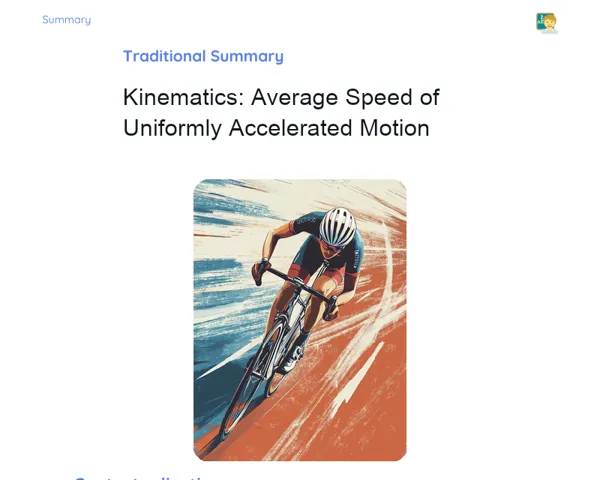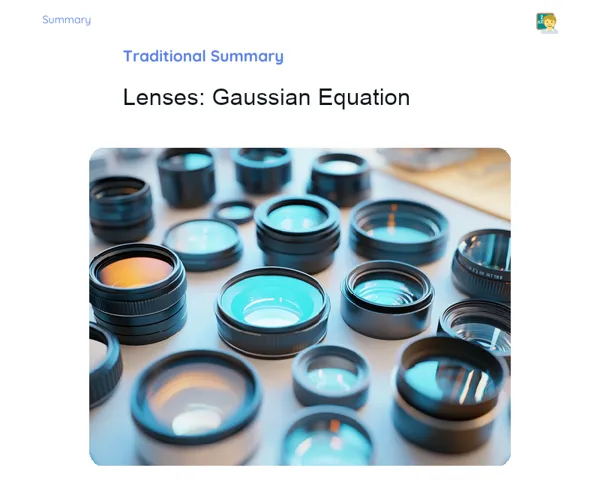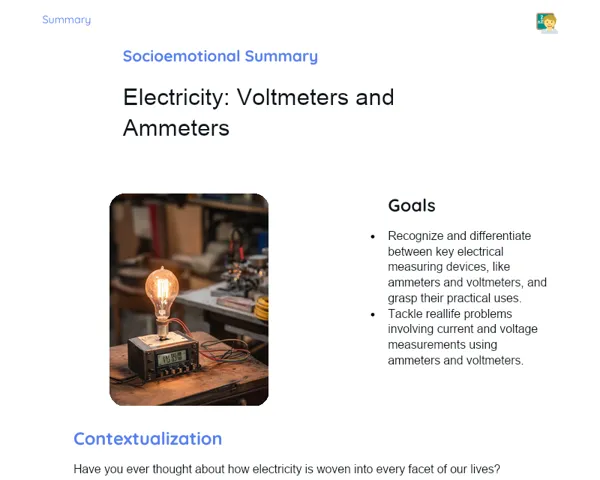Summary Tradisional | Kinematics: Average Scalar Acceleration
Contextualization
Kinematics is a vital branch of physics that focuses on the motion of objects without delving into the reasons behind that motion. A key concept within this field is acceleration, which explains how an object's speed changes over time. Average scalar acceleration, specifically, helps us measure the average change in an object's speed over a designated time interval. This concept is crucial for comprehending the movements we see daily, like a car speeding up or a train slowing down when it brakes.
To grasp average scalar acceleration, we must first familiarize ourselves with its basic formula: a_m = (v_f - v_i) / Δt. Here, 'a_m' stands for average scalar acceleration, 'v_f' refers to the final speed, 'v_i' represents the initial speed, and 'Δt' denotes the time interval. The standard unit for measuring acceleration in the International System of Units (SI) is meters per second squared (m/s²). With this knowledge, we can effectively calculate how an object's speed fluctuates over time, which is essential for both theoretical insights and practical scenarios in physics.
To Remember!
Definition of Average Scalar Acceleration
Average scalar acceleration is a measure that indicates the change in an object's speed over a specific time frame. It is calculated by dividing the difference in scalar speed (Δv) by the time interval (Δt) in which that change took place. To calculate average scalar acceleration, we use the formula: a_m = (v_f - v_i) / Δt, where 'a_m' signifies average scalar acceleration, 'v_f' is the final speed, 'v_i' is the initial speed, and 'Δt' is the time interval.
Understanding average scalar acceleration is essential for analyzing the behavior of moving objects. It allows us to accurately determine how an object's speed changes over time, which is critical for both theoretical studies and practical applications in physics. For instance, when looking at a car's motion, knowing its average scalar acceleration clarifies how quickly its speed alters and at what rate.
Moreover, average scalar acceleration plays a significant role in addressing real-world challenges we face daily. By identifying an object's average acceleration, we can anticipate its future movements, adjust parameters for optimal functioning, and ensure safety in various settings, such as operating vehicles and machinery.
-
Average scalar acceleration is the change in scalar speed divided by the time interval.
-
Formula: a_m = (v_f - v_i) / Δt.
-
Crucial for comprehending the behavior of moving objects and tackling real-life challenges.
Units of Measurement
In the International System of Units (SI), the standard unit of measurement for acceleration is meters per second squared (m/s²). This means that when calculating average scalar acceleration, we assess how many meters per second an object's speed changes each second. Maintaining this unit of measurement is essential for ensuring the accuracy and consistency of calculations in physics.
While other units can describe acceleration, it's vital to convert them to SI when solving problems. For example, if a car's speed is noted in kilometers per hour (km/h), it should be converted to meters per second (m/s) before determining the average acceleration. This guarantees consistency and accuracy in calculations.
Furthermore, understanding measurement units for acceleration is critical for interpreting experimental results and simulations. Comparing various motion scenarios—such as a car's acceleration on a racetrack or a train's deceleration while braking—using the standard measurement unit enables straightforward comparisons and provides a clearer understanding of the observed behaviors.
-
Standard unit of measurement for acceleration in SI: meters per second squared (m/s²).
-
Other units need conversion to SI for accurate results.
-
Ensures accuracy and consistency in calculations.
How to Calculate Average Scalar Acceleration
To compute average scalar acceleration, we use the formula a_m = (v_f - v_i) / Δt. This requires determining the change in scalar speed (Δv) and the time interval (Δt) during which that change occurs. For instance, if a car accelerates from 0 m/s to 20 m/s in 10 seconds, the average acceleration is (20 m/s - 0 m/s) / 10 s = 2 m/s².
It’s essential to ensure that all units of measurement align with the International System (SI). This means speeds should be recorded in meters per second (m/s) and time in seconds (s). Any inconsistencies in units can lead to significant errors in outcomes.
Additionally, practicing how to calculate average scalar acceleration with real-life examples helps reinforce the understanding of this concept. By working on practical situations, such as determining a car's acceleration on a racetrack or a train's deceleration, students can see the application of theory in real-world problems and enhance their ability to tackle complex physics scenarios.
-
Formula for calculating average scalar acceleration: a_m = (v_f - v_i) / Δt.
-
Crucial to ensure all measurements align with the International System (SI).
-
Practical examples bolster comprehension of the concept.
Graphical Analysis
Graphical analysis is a valuable method for grasping average scalar acceleration. In a velocity versus time graph, the slope of the line represents acceleration. A positive slope indicates acceleration, while a negative slope signifies deceleration. A graph with a steady slope denotes constant acceleration, whereas a variable slope suggests changing acceleration.
To compute average scalar acceleration from a velocity versus time graph, you simply calculate the slope of the line by finding the change in velocity (Δv) divided by the time interval (Δt). This graphical perspective aids in visualizing how an object's speed varies over time, enhancing the understanding of acceleration.
Moreover, graphical analysis is beneficial for interpreting experimental data and validating theoretical calculations. By comparing graphs from various scenarios, such as a car's acceleration on a racetrack or a train's deceleration, students can deepen their understanding of physical phenomena and apply this knowledge in practical ways.
-
The slope of the line in a velocity versus time graph indicates acceleration.
-
Positive slope shows acceleration; negative slope shows deceleration.
-
Graphical analysis aids in visualizing and understanding the changes in an object's speed over time.
Key Terms
-
Kinematics: A branch of physics exploring the motion of objects without considering the causes.
-
Average Scalar Acceleration: A measure that shows how an object's speed varies over a designated time frame.
-
Formula for Average Scalar Acceleration: a_m = (v_f - v_i) / Δt.
-
Unit of Measurement: Meters per second squared (m/s²) in the International System of Units (SI).
-
Graphical Analysis: A technique utilizing velocity versus time graphs to determine and visualize acceleration.
Important Conclusions
In this lesson, we delved into the concept of average scalar acceleration, crucial for understanding how an object's speed varies over a specific time interval. We covered the formula a_m = (v_f - v_i) / Δt, which enables us to compute an object's average acceleration, and highlighted the significance of adhering to the International System (SI) for accurate calculations. Furthermore, we explored how to interpret velocity versus time graphs to derive average acceleration, emphasizing the slope of the line as a graphical representation of acceleration.
The insights we gained regarding average scalar acceleration are fundamental not just for tackling theoretical physics problems but also for practical applications in our everyday lives, such as evaluating vehicle performance and ensuring safety across various scenarios. The ability to calculate and comprehend average acceleration empowers students to analyze and predict the behavior of moving objects, laying the groundwork for advanced studies in mechanics and other fields of physics.
We encourage students to continue investigating this topic and apply the concepts learned in practical scenarios and experiments. A solid grasp of average scalar acceleration will act as a stepping stone to more advanced topics in kinematics and other branches of physics, giving a wider and richer understanding of the physical phenomena we encounter daily.
Study Tips
-
Practice solving a variety of problems related to average scalar acceleration to strengthen your understanding and calculation abilities.
-
Utilize velocity versus time graphs to visualize and interpret average acceleration across different scenarios, ensuring clarity in grasping the concept.
-
Review the units of measurement in the International System (SI) to maintain precision and consistency in your calculations and experiments.



